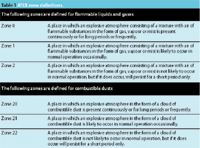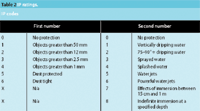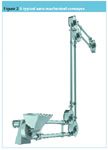Lost in the ATEX Maze?
Pharmaceutical Technology Europe
The EU ATEX Directive 1999/92/EC (ATEX 137) regarding the minimum requirements to protect the health and safety of workers potentially at risk from explosive atmospheres came into European law in January 2000. In the UK, the ATEX 137 Directive has been implemented as part of the Dangerous Substances and Explosive Atmospheres Regulations (DSEARs), which were issued in December 2002.
The EU ATEX Directive 1999/92/EC (ATEX 137) regarding the minimum requirements to protect the health and safety of workers potentially at risk from explosive atmospheres came into European law in January 2000. In the UK, the ATEX 137 Directive has been implemented as part of the Dangerous Substances and Explosive Atmospheres Regulations (DSEARs), which were issued in December 2002.
The directive requires that specific risks arising from explosive atmospheres are assessed and that employers classify places where explosive atmospheres may arise and select appropriate work equipment to use in these areas. The directive applies fully to workplaces put into operation for the first time or modified after 30 June 2003. Existing workplaces have until 30 June 2006 to fully comply with the directive. For new workplaces in operation after 30 June 2003, explosion safety must be verified by a person competent in the field of explosion protection with appropriate experience and professional training.
To assess explosion risks, places where explosive atmospheres may arise must first be identified. When such atmospheres occur in sufficient quantities to require special precautions to protect the health and safety of workers, they must be considered as hazardous areas and zoned according to the likelihood and frequency of explosive atmospheres occurring.
When defining hazardous areas it is important to be realistic about zone extents and to avoid unnecessary blanket zoning, particularly when the zones in question are Zones 0 or 20, or Zones 1 or 21, which indicate that explosive atmospheres are present either frequently or occasionally in normal operation (Table 1). Such concentrations (e.g., typically >20000 ppm for gases/vapours or >50 g/m3 for dusts) are several orders of magnitude greater than occupational exposure limits permitted under the Control of Substances Hazardous to Health (COSHH) regulations. In the majority of cases, zones in the general workplace should be no worse than Zone 2 or 22.

Table1. ATEX zone definitions.
Categorized equipment
Appropriately categorized equipment should normally be selected for use in areas in accordance with EU ATEX Directive 94/9/EC (ATEX 100), as implemented in the UK by The Equipment and Protective Systems Intended for Use in Explosive Atmospheres Regulations (EPS), unless the risk assessment finds otherwise.
The Heath and Safety Executive (HSE) approved code of practice and guidance for DSEARs states that the phrase "unless the risk assessment finds otherwise" is intended to introduce a degree of flexibility to allow equipment of a higher or lower category than normally required for the zone in question to be used where:
- equipment is temporarily taken into a zoned area and alternative effective precautions are in place to control the risk
- workers can be excluded from the hazardous area and will not be at risk from ignition of an explosive atmosphere
- equipment of the required category is not available, but a lower category can be used in combination with other protective measures to achieve the purposes.
One misconception that has arisen in equipment selection is that the zone inside the equipment is relevant when determining the appropriate ATEX category of the equipment. This is not the case. The fact that a potentially explosive atmosphere may be present within the equipment is not relevant when selecting equipment, unless devices with an autonomous function are installed within the equipment (e.g., level probes). Instead, it is the zone in the workplace that is relevant when identifying the category of equipment that must be installed and, in the majority of cases, this means that Category 3 equipment will suffice. However, consideration must still be given to internal ignition sources as legislation also requires that equipment is safe to handle in explosive atmospheres.
Another misconception is that existing equipment in hazardous areas must be replaced by ATEX-categorized equipment. However, existing equipment does not need to be replaced or upgraded if it complies with legislation in force before 1 July 2003 and is in fact considered safe. Equipment purchased before 1 July 2003 and held in stores can be installed in hazardous areas after 1 July 2003 as long as it meets the same criteria. Similarly, second hand equipment put onto the market before 1 July 2003 does not need to comply with EPS if it is safe to use in hazardous areas.
For equipment acquired before 1 July 2003 or second hand equipment originally placed on the market before 1 July 2003, only electrical equipment used in hazardous areas requires specific protection. A distinction is made between electrical equipment installed in dust hazardous areas and that installed in gas/liquid hazardous areas.

Table 2. IP ratings.
The former is protected by enclosing the apparatus to limit the amount of dust that could enter the enclosure and come into contact with sources of ignition (Ingress protection [IP] rating), while the latter is protected by selecting an appropriate type of protection from one of the following methods (explosion [Ex] rating [Table 2]):
- preventing the occurrence of sparks by design
- protecting the apparatus by an enclosure that will contain an explosion and prevent its spread
- limiting the energy of sparks so that explosions do not occur and prevent hot surfaces occurring
- preventing the gas/vapour reaching any sparking or hot components.
In addition to the above, the maximum surface temperature of all electrical apparatus should be restricted to ensure that hot surfaces will not ignite flammable gases/vapours or combustible dust clouds or layers.
The Ex ratings relate to the protection offered by electrical equipment for hazardous environments. For example, all equipment used in mines has to be Group 1 (I) and anything for above ground use is Group 2 (II). Each group is broken down into protection categories. An Ex Group II Category 2 rated motor, for example, offers a high level of protection when operating above ground in a gaseous or dusty atmosphere.
Equipment selection
It must be recognized that once the hazardous zone is defined, the selection of equipment is based only on the likelihood of ignition not the consequences of ignition. Consequently, area classification and selection of appropriately categorized equipment does not in itself constitute a suitable and sufficient risk assessment. To control explosion risks a suitable basis of safety for process operations in hazardous areas should be defined and consideration must be given to both the likelihood and consequences of ignition. The basis of safety is defined as the fundamental safety philosophy, which ensures that an item of equipment can be operated, or an operation performed, in a safe manner with the risks as low as reasonably practicable. For equipment or operations handling flammable gases/liquids or combustible dusts safety can be based on either explosion prevention or explosion protection.
Explosion prevention eliminates the need for protective measures and can be implemented by the following strategies:
- avoiding flammable atmospheres (e.g., inerting under a blanket of nitrogen or using alternative nonflammable gases)
- eliminating ignition sources (e.g., hot work control, no-smoking policies, no hot surfaces, construction using nonsparking metals).
Explosion protection accepts that, in spite of measures being taken to prevent an explosion, the explosion risk warrants further measures to mitigate the consequences if one should occur. In determining whether explosion protection is necessary then it must be recognized that ignition sources have a habit of arising, often through human error. The potential consequences of an explosion should be assessed and the explosion risk kept as low as reasonably practicable. Explosion protection can be implemented by the following strategies:
- explosion containment (i.e., designing for maximum explosion pressure)
- explosion suppression (i.e., installing extinguishing system)
- explosion venting (i.e., providing weak panels to relieve pressure)
- explosion isolation (i.e., preventing explosion propagation).
A third misconception is that existing explosion protection systems (e.g., vent panels) must also be replaced by ATEX-certified systems. However, this is not the case as long as the systems can be shown to provide effective protection (e.g., aluminium panels secured by nylon bolts).
It is important when identifying explosive atmospheres to be realistic about zone definitions and extents. New equipment should be selected according to the zone housing it and existing equipment should be suitably Ex- or IP-rated. Finally, the consequences of ignition must be considered and an appropriate basis of safety defined to ensure that explosion risks are as low as reasonably practicable (ALARP).
Conveyors and dischargers
Mechanical conveyors and bulk bag dischargers are often found in the dry, particulate raw materials receiving, handling and processing departments of pharmaceutical companies. Consider two types of mechanical conveyors as practical examples: flexible screw conveyors and aero-mechanical conveyors.
Flexible screw conveyors. Flexible screw conveyors consist of a heat-treated carbon or stainless steel spiral rotating within a semiflexible conveying tube (Figure 1). Most commonly, this tube is of food grade ultra-high molecular weight polyethylene (UHMWPE). Flexible screw conveyors typically offer the simplest and lowest cost solution for multiple powder conveying applications.

Figure 1. A typical flexible spiral conveyor.
The motor, safety interlocks, level probes and any other electrical equipment are readily specified for the designated zone. Flammable dust concentrations will not normally be generated within the conveyor itself because of the nature of the flexible screw conveying action. The combination of a steel spiral and a plastic conveying tube ensures that there is no friction to cause any heat build-up. The external surface of the conveying tube does not have a charging mechanism and any static generated internally is dissipated through the spiral. In fact, flexible spiral conveyors are used extensively in the explosives industry because of the inherent safety of their construction.
Aero-mechanical conveyors. Aero-mechanical conveyors, which are also called 'rope and disc' conveyors, are also used (Figure 2). A continuous rope, with a series of equally spaced discs secured to it, travels through a delivery-and-return tube circuit at high speed. Aero-mechanical conveyors provide an effective means of mechanical pneumatic conveying and are not to be confused with drag link conveyors, which operate at much lower speeds.

Figure 2. A typical aero-mechanical conveyor.
Although the air-to-product ratio within an aero-mechanical conveyor is more likely to give rise to flammable dust concentrations in normal operation, the design of such conveyors controls the dust explosion risks. Again, similar to flexible spiral conveyors, their design is a combination of plastic and metallic parts, which eliminates the risk of sparks. Aero-mechanical conveyors are quite safe to use in hazardous environments provided the electrical equipment is correctly specified.
Both types of conveyor are used in the pharmaceutical industry mainly for handling dry bulk ingredients. Many of these ingredients are supplied in flexible intermediate bulk containers (FIBCs). Bulk bag dischargers readily work in conjunction with the types of conveyors mentioned above (Figure 3).

Figure 3. A typical bulk bag discharger.
Bulk bag dischargers. The worldwide acceptance of bulk bags has brought big changes to bulk materials handling and the biggest names in the pharmaceutical industry are using them to replace rigid intermediate bulk containers (IBCs). Bulk bags and, equally important, their associated filling and discharge systems have made strident advances in hygiene and containment — in fact offering containment levels as good as 25 µg/m3 . Lined bulk bags avoid cross-contamination between batches and eliminate the need for and cost of cleaning/revalidation associated with traditional rigid bins.
Properly specified electrics and good housekeeping bulk bag dischargers can be operated quite safely because extensive flammable dust concentrations are unlikely to arise in normal operation. As mentioned earlier, it would be unreasonable for operators to work in areas that pose the highest risks anyway.

Key points
As with most equipment, one of the biggest risks is the accidental ingress of metallic foreign bodies that can cause sparks directly or indirectly by causing moving machinery to fail in some way. Thus, it is imperative that operators take every precaution to ensure that such objects cannot enter equipment that would be put at risk.
Many equipment manufacturers work with explosion safety consultants who are well versed in the theory and application of ATEX regulations. Their customers are often referred to specialist companies to assist in determining their zoning. After all, it falls to the operating company itself to specify the zoning in their plant. However, the danger is that, in doing so, extreme caution will lead to paying excessive and unnecessary costs for process, handling and storage equipment for their raw materials and they will design for zones beyond those required in practice. Safety consultants have the training and experience to make the most practical recommendations.
Bibliography
1. Dangerous Substances and Explosive Atmospheres Regulations 2002. Approved Code of Practice and Guidance L138 www.hse.gov.uk/fireandexplosion
2. Dangerous Substances and Explosive Atmospheres Regulations 2002. Approved Code of Practice and Guidance L134 www.hse.gov.uk/fireandexplosion
3. Dangerous Substances and Explosive Atmospheres Regulations 2002. Approved Code of Practice and Guidance L135 www.hse.gov.uk/fireandexplosion
4. Dangerous Substances and Explosive Atmospheres Regulations 2002. Approved Code of Practice and Guidance L136 www.hse.gov.uk/fireandexplosion
5. Dangerous Substances and Explosive Atmospheres Regulations 2002. Approved Code of Practice and guidance L137 www.hse.gov.uk/fireandexplosion.
Steve Meeson is senior electrical engineer at Spiroflow Ltd, UK. Andrew Dickens is director of Phoenix Loss Prevention Ltd, UK.
Pharmaceutical Tariffs Are Imminent: How Industry is Bracing for Impact
April 16th 2025On April 14, 2025, the Trump Administration launched a national security-driven investigation into pharmaceuticals, a move that will likely result in tariffs being placed on pharmaceutical drugs, ingredients, and other components that are imported from outside of the United States.
